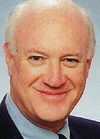Steve Crocker
 |
 |
| Country: | USA |
| Email: | steve [at] stevecrocker.com |
Dr. Crocker is the Co-Founder and CEO of Shinkuro, Inc., the current Vice-Chair of the ICANN Board, an Internet pioneer, an early leader of ISOC and the IETF, and the creator of the RFC document series.[1][2]
Internet Pioneer[edit | edit source]
RFC[edit | edit source]
Steve Crocker was a graduate student at UCLA in the late 1960s and early 70s, and along with Vinton Cerf and Jon Postel,[3] was part of the team that developed the protocols for the ARPAnet.[4] Steve was the humble man who wrote the first RFC, or Request For Comments, a document series wherein questions and answers to the pressing technical issues were presented to and by the entire engineering and infrastructural community. Dr. Crocker labeled the first memo as such as he did not want to seem presumptuous or authoritative, but rather facilitate discussion and progress within the community.[5] The first RFC was published April 6th, 1969; and it can be read here, Steve's retrospection on the beginning of the series on its 40th anniversary can be read here.
The RFC series began before the network was actually working, and before email was possible. Thus, they were physically mailed to each research center, and then circulated.[6]
Beginning[edit | edit source]
Dr. Crocker attended the same high school in southern California as both Jon Postel and Vint Cerf,.[7] and has described Vint as his best friend.[8] In 1965, while at UCLA, Steve an ARPA supported project, which was a precursor to the actual ARPAnet.[9] The project dissolved, and the remaining DARPA funds were transferred to Gerald Estrin in the Computer Science Department; Steve began to work him in 1966. In 1977 he was at MIT working on more graduate studies, but within a year and a half he had returned to UCLA. He was drawn to MIT given their Artificial Intelligence programs. In 1968 he was back at UCLA, and given that his friend Vint was looking to enroll in a graduate program, he introduced him to Estrin; shortly thereafter Vint was a part of the school's graduate program. That summer they were both working on the ARPAnet project. By 1970 he had been given a job with ARPA in Washington, D.C., rather than the previous position as a graduate student engaged mainly at the UCLA campus. He was now managing the protocol of various sites and contractors spread throughout the U.S., and he also required to travel to Europe.[10]
The organization and communication work involved in the RFC series and the interoperability of the first network sites led Steve to found the Networking Working Group, and ask Vint to be its first Chairman;[11] the group is the predecessor of the Internet Engineering Task Force.[12]
Current Work[edit | edit source]
Dr. Crocker is CEO and co-founder of Shinkuro, Inc., which is focused on dynamic sharing of information across the Internet.[13]
ICANN[edit | edit source]
Steve Crocker has been involved in both the Internet and ICANN since their beginnings. He has been the chair of ICANN's SSAC since its creation in 2002, and had been serving as the SSAC's non-voting liaison to the ICANN Board until he was selected by the NomCom to serve as a voting member. He was selected by the NomCom in 2008, and his current term concludes at the end of the 2011 annual meeting. Following the annual meeting of 2010, Steve was elected as Vice-Chair of the ICANN Board.[14]
He remained active in the Internet standards work through the IETF and IAB. For this work, Dr. Crocker was awarded the 2002 IEEE Internet Award.
Dr. Crocker's experience includes research management at DARPA, USC/ISI and The Aerospace Corporation, vice president of Trusted Information Systems, and co-founder of CyberCash, Inc. and Longitude Systems, Inc. He is also on the board of The Internet Society and he is a volunteer Senior Counselor in the Office of the Chief Technology Officer in the District of Columbia, focusing on the District's creation of a new technology magnet high school.
Education[edit | edit source]
Dr. Crocker earned his BA in math and PhD in computer science at UCLA, and he studied artificial intelligence at MIT.
